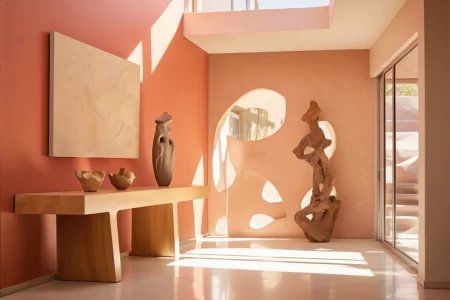 When it comes to interior design, achieving the perfect balance between harmony and contrast can make your space truly captivating.
When it comes to interior design, achieving the perfect balance between harmony and contrast can make your space truly captivating.
Visual contrasts can breathe life into your interior, adding depth, interest, and a touch of sophistication.
Here’s a guide to help you infuse your living spaces with eye-catching visual contrasts.
1. Color Play
Contrasting colors are a powerful tool in interior design. Pairing complementary colors, like blue and orange or purple and yellow, can make each hue pop, creating a dynamic visual effect.
Consider using contrasting colors in accents, furniture, or even on an accent wall to make a statement.
2. Material Mix
A mix of textures and materials can instantly add depth to your interior. Combine smooth surfaces with rough ones, like pairing a sleek leather sofa with a rustic wooden coffee table.
Incorporating materials such as glass, metal, fabric, and stone can create a tactile experience that engages both the eyes and the senses.
3. Light and Dark
Experiment with light and dark elements to establish a compelling visual balance. Play with shadows by using pendant lights or floor lamps strategically.
Dark furniture against light walls, or vice versa, can create an appealing contrast that draws attention to key design elements.
4. Size Matters
Varying the scale of objects in your interior can create intriguing visual dynamics. Combine large statement pieces with smaller ones to avoid monotony and capture attention.
An oversized artwork above a delicate side table, or an expansive mirror alongside dainty decorations, can make your space more visually engaging.
5. Patterns and Solids
Incorporating patterns amidst solid colors can introduce a sense of drama and energy. Geometric patterns, stripes, or floral motifs can be introduced through textiles, wallpapers, or even rugs.
The key is to balance patterned elements with solid backgrounds to maintain a visually pleasing equilibrium.
6. Minimalism and Maximalism
Whether you lean towards a minimalist or maximalist aesthetic, contrasts can still play a pivotal role. In minimalism, sparse furnishings against an empty backdrop can create a sense of tranquility.
On the other hand, maximalism thrives on contrasting an array of bold elements, resulting in an eclectic and vibrant ambiance.
By thoughtfully balancing these contrasting elements, you’ll create a visually stimulating space that’s uniquely yours.
Picture Credit: Freepik



